With some of the fruits in this list, it’s the skin that’s bright yellow. Others you have to open to appreciate the sunny color. Some are sweet and juicy while others are tart and stingy with their juice. Discover 27 yellow fruits, including what they look like and what they taste like!
Discover 27 Yellow Fruits: The Complete List
1. Pineapple
This tropical fruit is native to South America. It has a distinctive sweet flavor and its outer skin resembles a pine cone. It can be enjoyed alone in chunks or rounds and makes a wonderful ingredient in dishes and drinks, including cocktails!
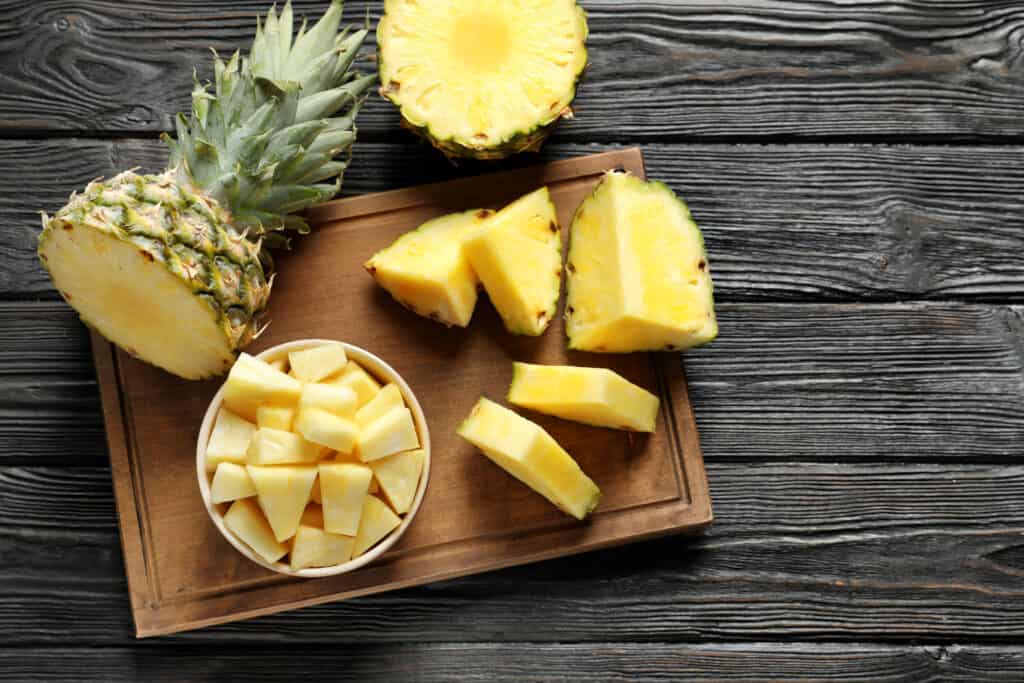
Pineapple has a tangy, sweet flavor you can enjoy alone or as part of a dish or drink.
©New Africa/Shutterstock.com
2. Mango
Mangoes come in different colors, including red, green, and yellow and the flesh inside can be either an orangish color or a brighter yellow. You can enjoy the flesh of the fruit alone or blend it into a smoothie, make chutney, or prepare a delectable dessert.
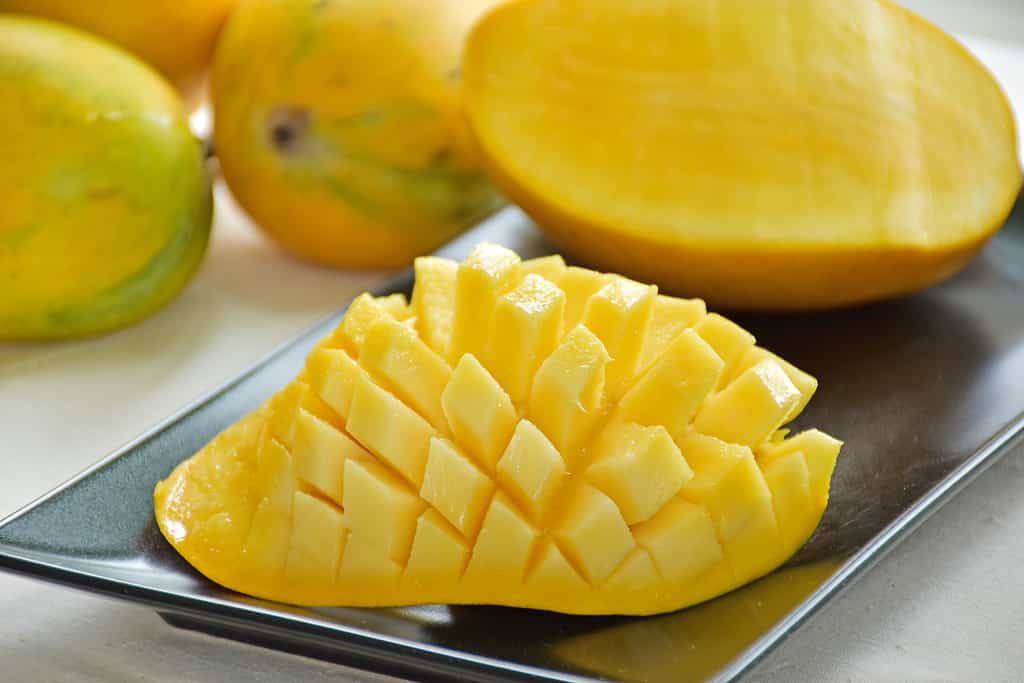
Mango is a refreshing fruit you can peel and enjoy.
©Patnaree Asavacharanitich/Shutterstock.com
3. Lemon
This citrus fruit is shaped like an oval and has an acidic flavor and a strong aroma. You can use it to make fresh lemonade, dry it for a crispy, sour snack, or turn it into candy. You can also enjoy the fresh flesh alone for a tart, mouth-watering flavor.

Lemons have an acidic flavor and pleasant aroma.
©iStock.com/PJjaruwan
4. Banana
On the inside, it’s a cream color but when it’s ripe, its skin is yellow. This is a sweet, creamy, potassium-rich fruit that you can peel and eat alone or blend into a smoothie, add to oatmeal, or enjoy in a mixed fruit salad.
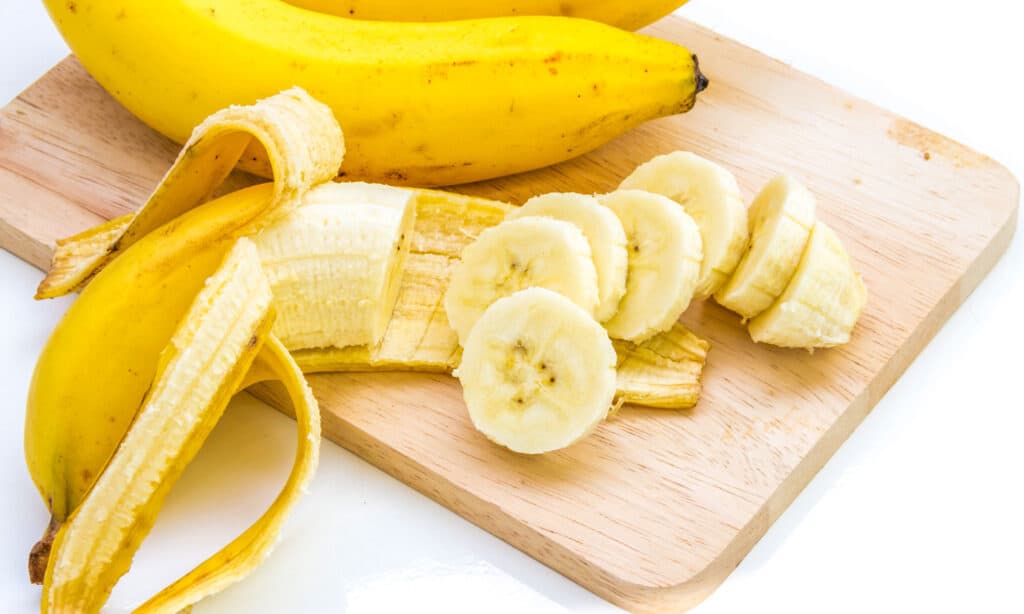
Bananas are rich in potassium.
©Monning27/Shutterstock.com
5. Eggfruit
It looks kind of like a mango except its end is pointed. You can peel the skin off when it’s ripe and enjoy the soft flesh (just mind the large seeds!). Its flavor is both bold and sweet.

Eggfruit resembles mangoes but the shape is a bit different.
©iStock.com/JokoHarismoyo
6. Loquat
Loquat, also known as a Japanese plum, is a small, round fruit. Sometimes they’re a little bit fuzzy and sometimes they’re smooth. When ripe, this fruit displays an orange and yellow color. The flesh is firm yet has a tender quality and tastes sweet with a slight tanginess.
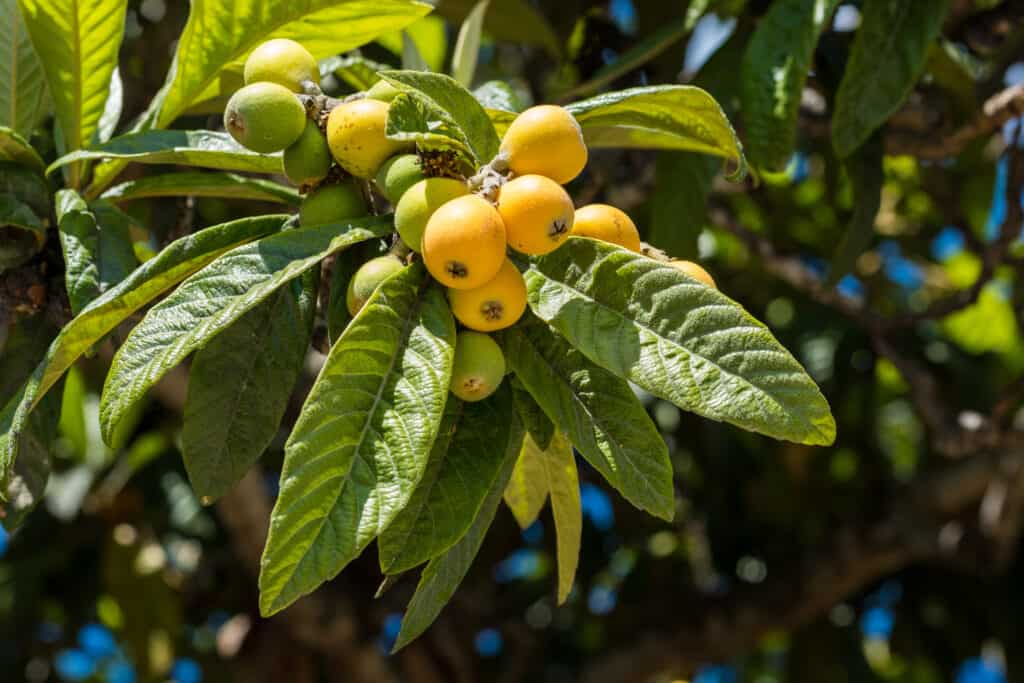
Loquat leaves are large and glossy green on the upper side and rust or white on the underside.
©iStock.com/kornyeyeva
7. Yellow Apple
No, apples are not always red. They can be yellow, too! Golden delicious apples boast this yellow color but they’re not the only ones. There are also criterion apples, gravenstein apples, blondee apples, and more. These are versatile, and you can eat them alone or use them to make apple sauce, apple butter, or make it a crunchy addition to your favorite salad!
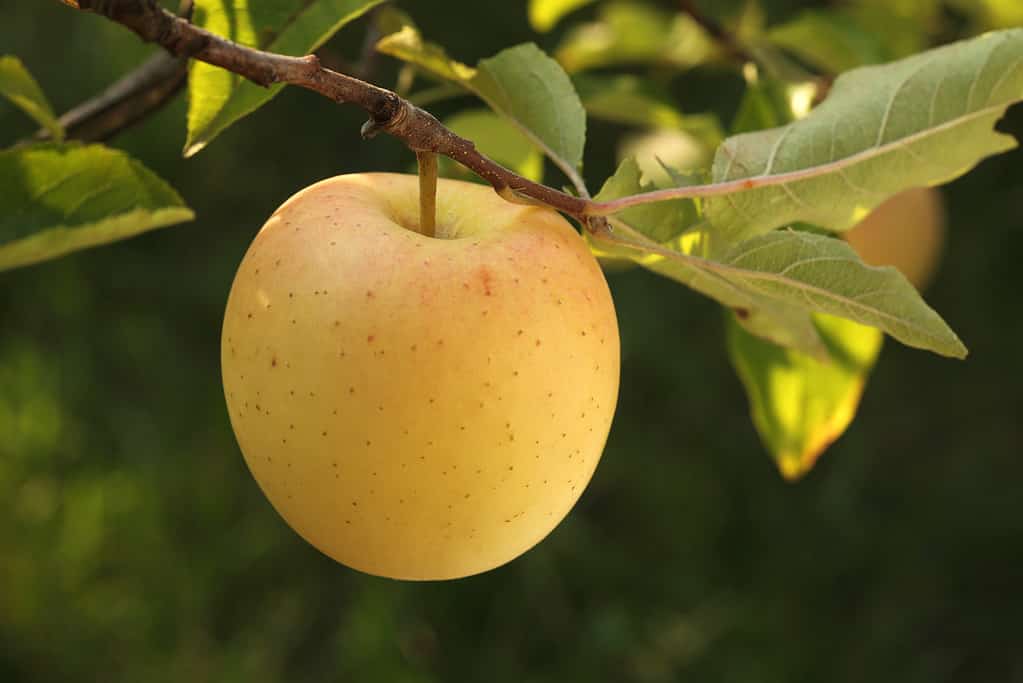
Golden delicious apples are just one of the many yellow apple varieties.
©Shulevskyy Volodymyr/Shutterstock.com
8. Quince
This pear-like fruit is unlike other yellow fruits on this list. If it’s raw, it’s too tough. To thoroughly enjoy what this fruit has to offer, you must cook it first. This is how the flesh softens and the yellow flesh of the fruit shifts to a warmer pink color. It’s great for baking into tarts and pies but you can also roast it or turn it into a jam or jelly.

Quince fruit is shaped much like a pear but has a rather tough texture in its raw form.
©khuntapol/Shutterstock.com
9. Durian
Known for its strong odor, durian is the type of fruit you either love or hate. It’s a tropical fruit with a spiny exterior that protects the inner creamy pulp. If you can get past the unpleasant smell, you can enjoy the custard-like fruit within that has notes of caramel and vanilla.

The spiny exterior of durian protects the soft, custard-like fruit inside.
©taveesak srisomthavil/Shutterstock.com
10. Canary Melon
This fruit is bright yellow on the outside with a paler yellow inside. It is oval-shaped, appearing much like a football. The flesh of the fruit may be as pale as ivory but may also incorporate some pale green. It’s both soft and juicy when ripe and has a sweet, tangy flavor.
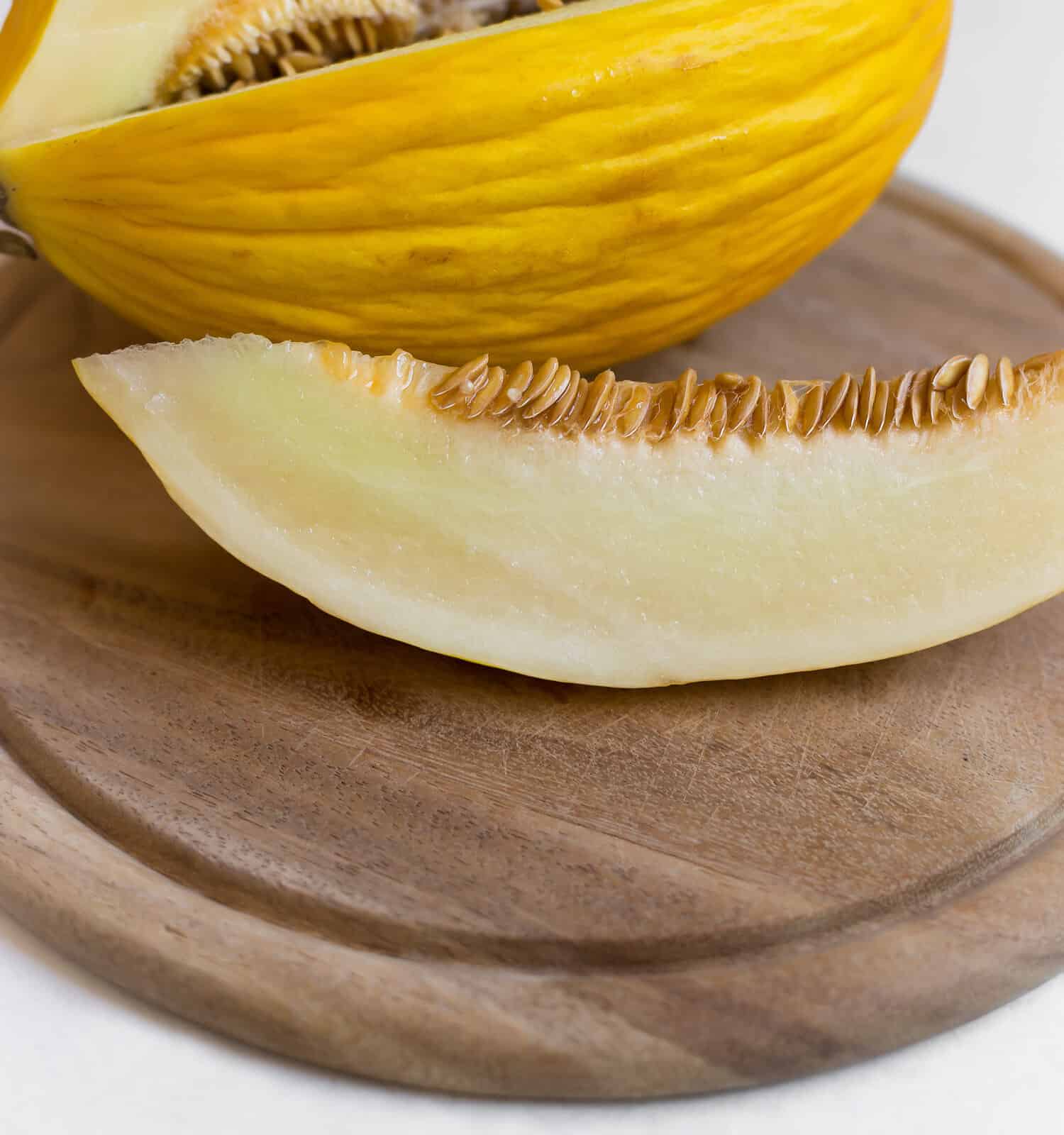
Canary melon has a strong tropical aroma reminiscent of banana and pineapple.
©Miriam Doerr Martin Frommherz/Shutterstock.com
11. Passion Fruit
From the outside, passion fruit may appear purple, red, or yellow (this depends on the variety). When you cut this fruit open, the inner flesh has shades of yellow in a jelly-like consistency. The seeds within are crunchy, adding to the otherwise gelatinous texture. Eat it with a spoon to enjoy the fruity flavors that taste like a combination of pineapple, melon, and kiwi.
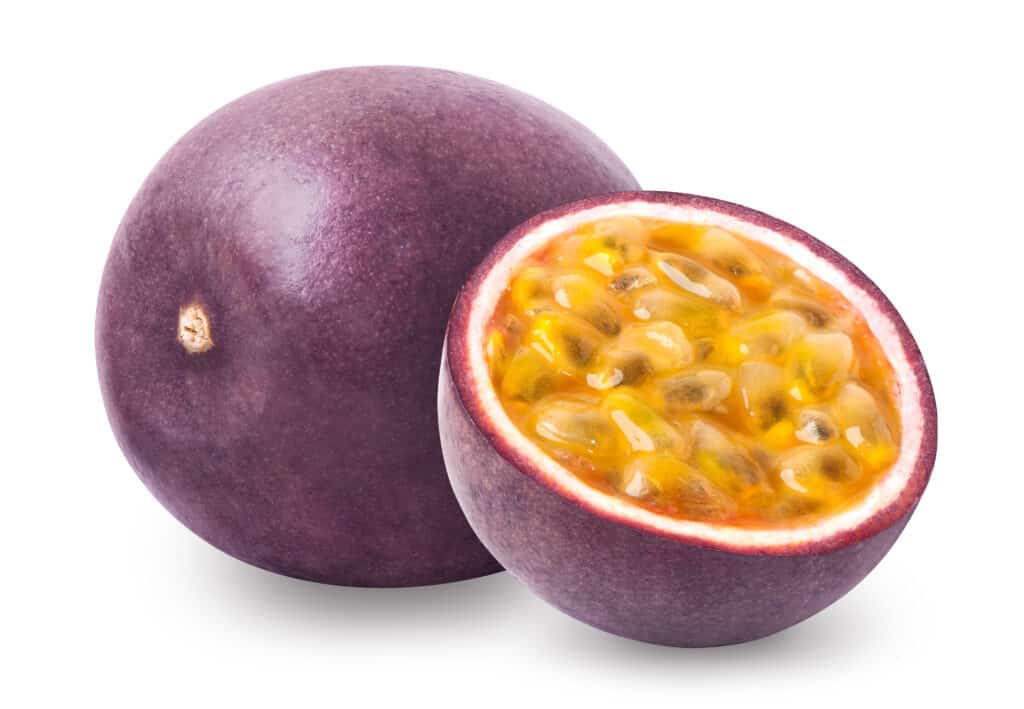
Passion fruit has a hard exterior that houses a soft, jelly-like fruit.
©Ekaterina Simonova/Shutterstock.com
12. Starfruit
When you cut starfruit, the pieces look like a star with five points. This fruit has a mildly sour flavor if its small but the bigger variety is a bit sweeter. They are either green or yellow and are rich in vitamin C.
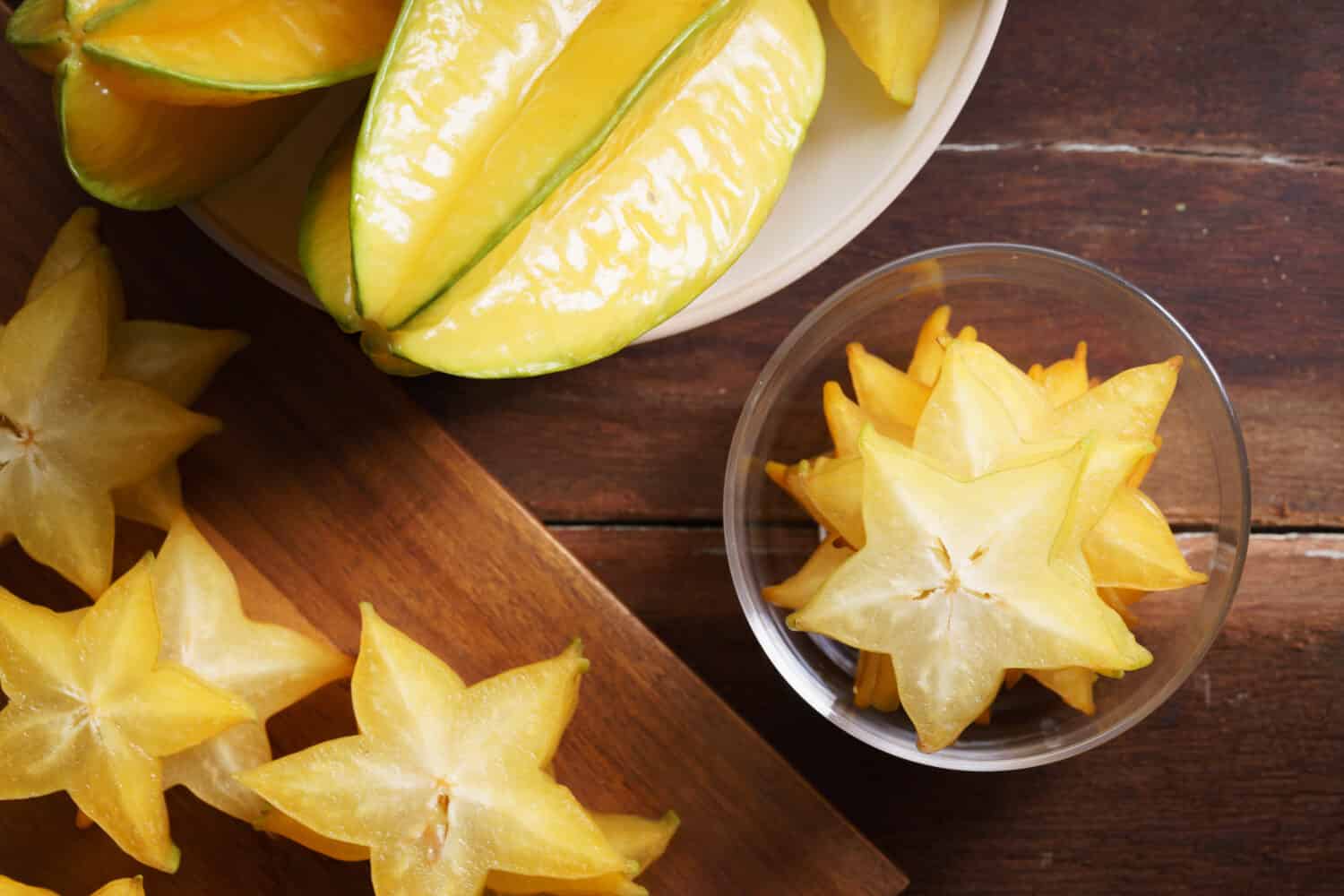
Starfruit is rich in vitamin C and fiber.
©janecocoa/Shutterstock.com
13. Yellow Pear
Asian pears resemble apples but they belong to the Pyrus genus. Enjoy this fruit raw in a salad along with prosciutto or poach some slices, adding ginger and vanilla to enjoy a delicious dessert.
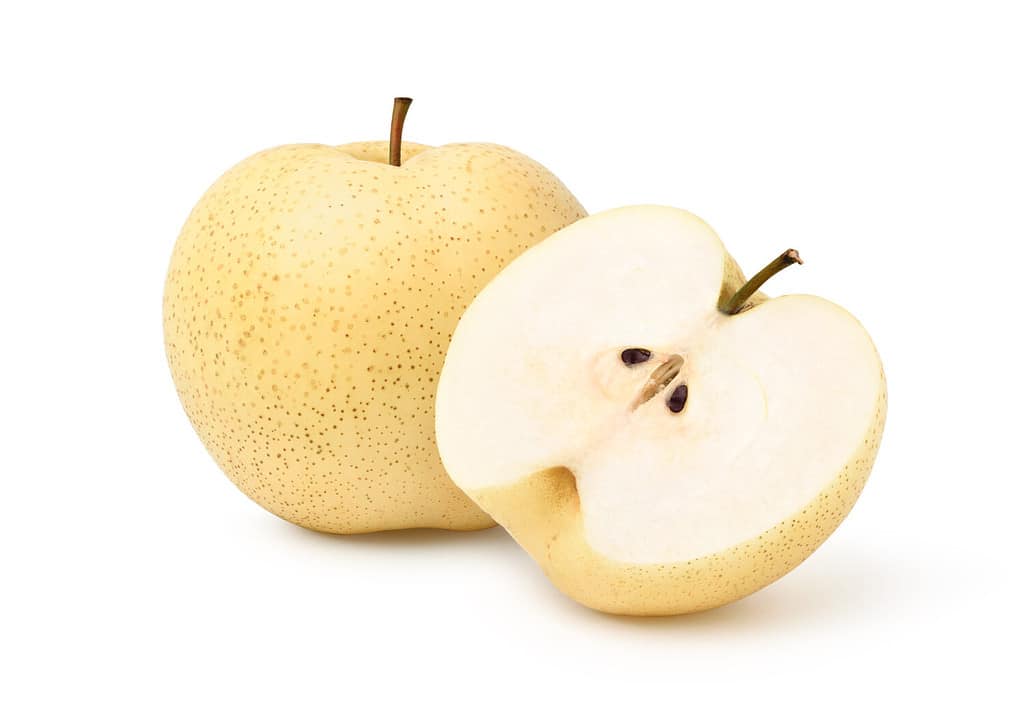
Though asian pears resemble apples, they’re technically pears.
©Photoongraphy/Shutterstock.com
14. Cape Gooseberries
These gooseberries, also known as goldenberries, are small fruits with a sweet and tart flavor profile. The flesh is juicy with a tropical flavor that many describe as a combination between pineapple and mango. The seeds contained within the fruit are tiny and edible.
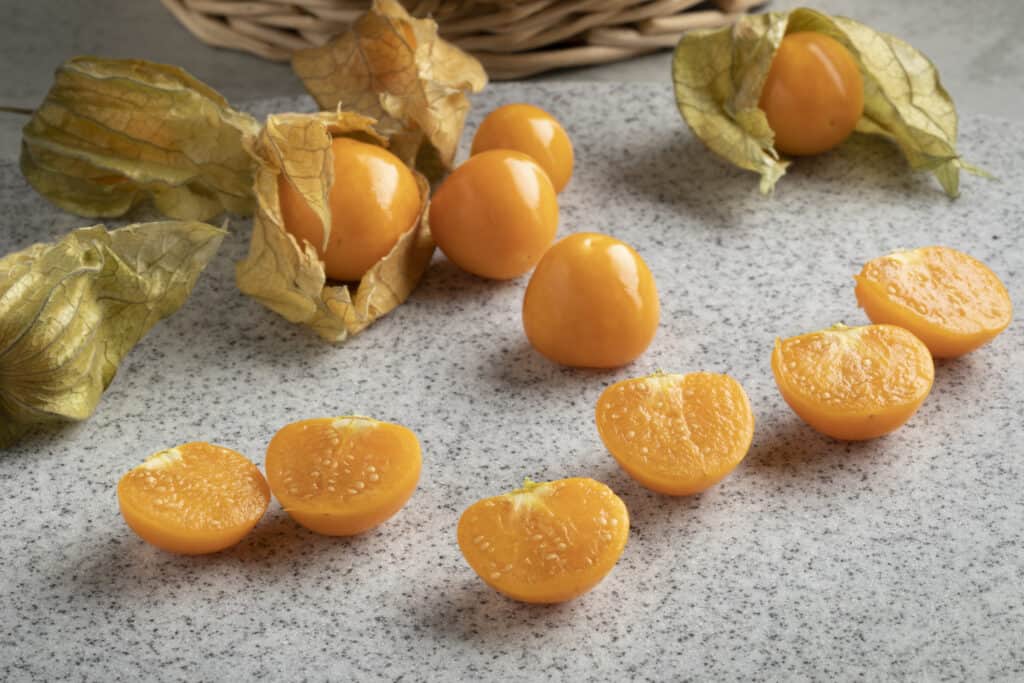
Goldenberries are penny-sized fruits with a yellowish husk you remove before consuming.
©iStock.com/PicturePartners
15. Yellow Fig
Figs come in different colors, including green, black, and yellow. The yellow variety goes by “honey fig” or “yellow longneck.” These fruits have a thin skin and a sweet flavor. Bite right in after washing because all parts of the fruit except the stem are edible.

Figs come in black, green, and yellow varieties.
©Eric Buermeyer/Shutterstock.com
16. Barhi Dates
Yellow Barhi dates are small fruits with an oval shape and before they ripen, they boast a golden yellow color. When ripe, the color of Barhi dates changes to a darker brown tone. It starts out smooth and eventually wrinkles. The flesh is smooth and sweet with a chewy texture.
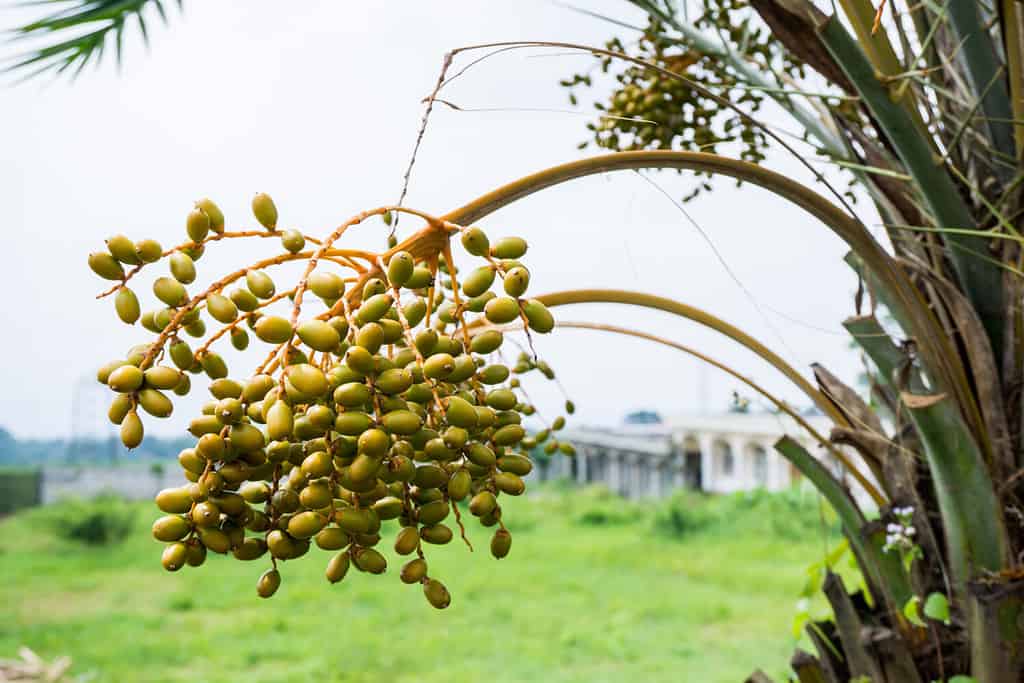
When Barhi dates ripen, their color changes to a darker brown and they get wrinkly.
©mozrid/Shutterstock.com
17. Cherry Plum
This fruit is round and tiny, up to two centimeters wide. When ripe, they develop a bright cherry color and inside, the fruit is a golden yellow color.
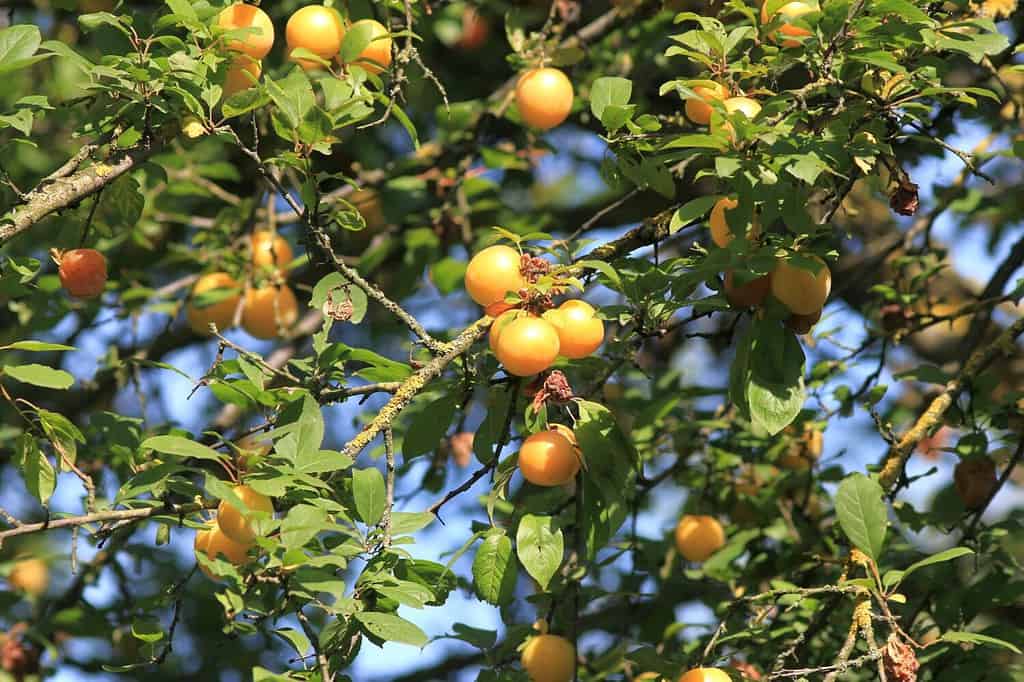
, or cherry plums, are hybrid trees with spectacular one-of-a-kind tasting fruits.
©Dina Rogatnykh/Shutterstock.com
18. Gold Raspberry
These yellow raspberries are small and made up of several drupelets that cluster together. The texture of these raspberries is bumpy and a little fuzzy. The flesh is soft and juicy with a honey-like flavor.
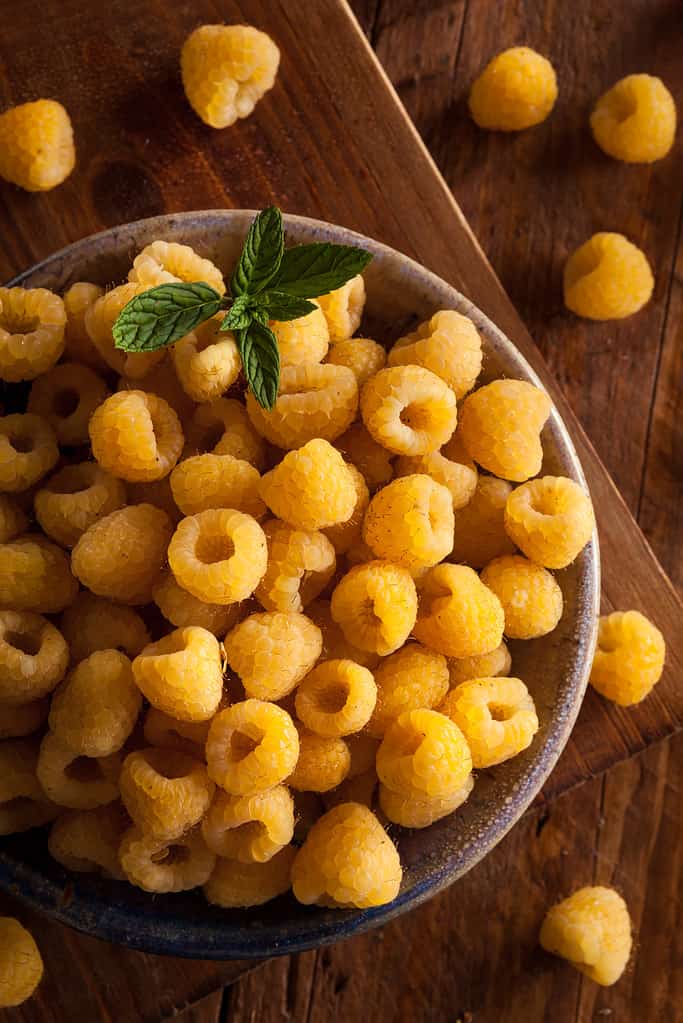
Gold raspberries are ever-so-slightly tart.
©bhofack2/ via Getty Images
19. Pomelo
This large Asian citrus fruit both looks and tastes like grapefruit. Except pomelo is a bit sweeter! The rind is thick and the flesh is packed with vitamin C and other vitamins and minerals.
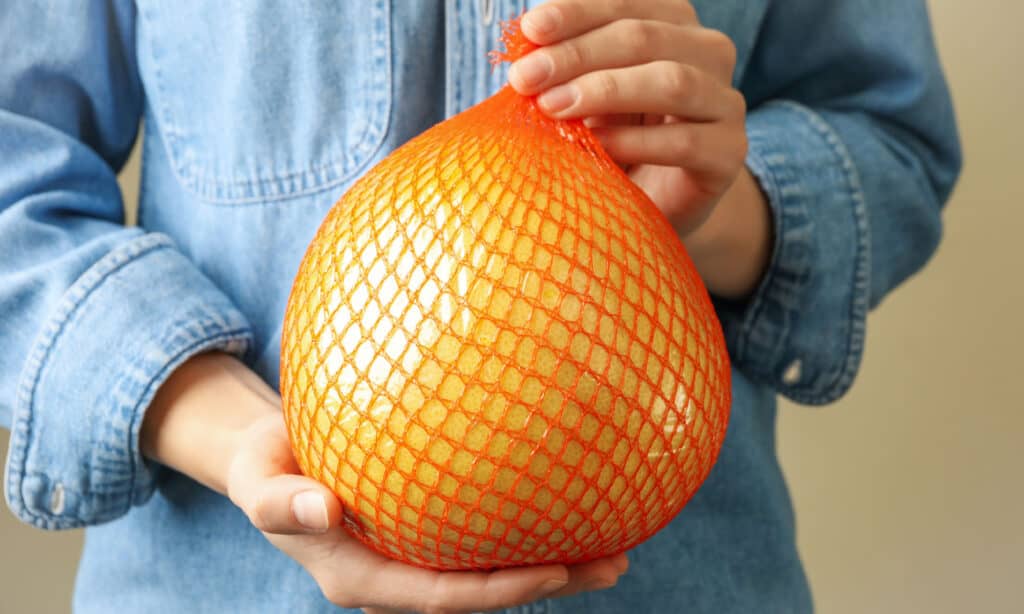
Pomelo is rich in antioxidants and may aid with weight loss.
©iStock.com/AtlasStudio
20. Yellow Guava
There are many types of guavas found throughout the world and yellow guava is native to both Mexico and Central America. Nevertheless, this fruit graces many parts of the world as it is grown in places like tropical Africa, Southern Europe, Southern California, and Florida. You can eat these at different stages. They don’t need to be ripe for you to enjoy them. Just eat them the way you would an apple!

You can eat guavas while they’re still ripening or once they’re fully ripe!
©BobNoah/Shutterstock.com
21. Mirabelle Plum
These plums have a sweet and subtle flavor and have quite an exclusive appeal. You can only import these directly from Lorraine in France. If you do happen to get your hands on one of these fruits, you might want to grow your own Mirabelle tree in your backyard (for personal use only!).
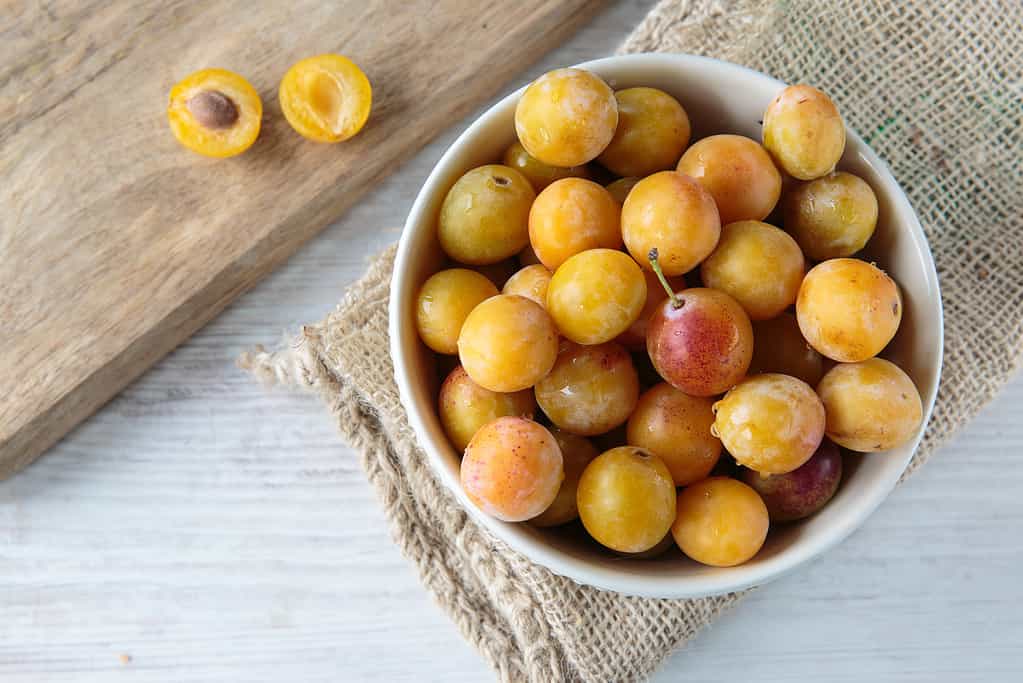
Mirabelle plums can only be imported from a certain region in France.
©graffio77/ via Getty Images
22. Golden Kiwi
The golden kiwi is a little bit bigger than its traditional counterpart, the green kiwi. However, the shape is generally the same appearing like an oval with rather blunt ends. It’s a less hairy version than the green kiwi, with most having smooth skin. The flesh holds its shape well but is still quite tender. It’s yellow and when you bite into it, it’s both fruity and sweet with a bit of tanginess.

Golden kiwis are larger than green kiwis.
©iStock.com/YayaErnst
23. Buddha’s Hand
This uniquely shaped fruit is aptly named since it is a citrus that has finger-like protrusions emanating from its center. Unlike the rest of the yellow fruit in this list, Buddha’s hand doesn’t have edible flesh. The inside is bitter; however, the outer layer can be used to add a blossom-like zest to a range of dishes.

Buddha’s hand does not have edible flesh.
©Peera_Sathawirawong/ via Getty Images
24. Grapefruit
This fruit is nutrient dense with a yellowish orange outer rind and a pinkish red fleshy center. It’s packed with fiber, vitamin C, and vitamin A. The flavor is acidic with a slight bit of sweetness. Slice it up to enjoy the fleshy bits, juice the pulp to enjoy its liquid, or put a salad together to savor it alongside other fruits or veggies.

Use a serrated knife to cut through the rind of a grapefruit.
©sergios/Shutterstock.com
25. Yellow Watermelon
It looks the same on the outside as your typical pinkish red watermelon but when you slice it open, what you see is a bright yellow fleshy center. Not only do they have the same green exterior but the texture and flavor profile of yellow watermelons is similar, albeit noticeably sweeter.
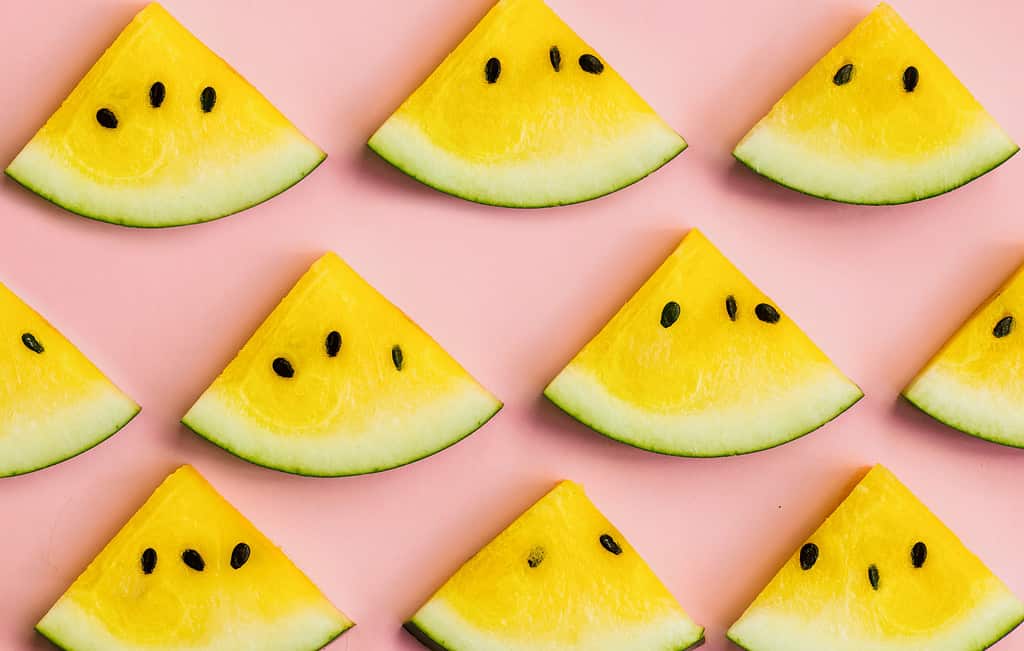
Yellow watermelons came before red watermelons!
©Anastasiia Krivenok/ via Getty Images
26. Yuzu
This citrus fruit has both a yellow exterior and interior. It originated in China and is known for being able to retain its strong sour flavor even when cooked at high temperatures. It has more seeds than lemons and is less juicy. The flavor is tangy, blending bitter and sweet notes.

Yuzu is a citrus fruit with a sour flavor.
©manbo-photo/ via Getty Images
27. Nectarine
They’re technically a type of peach but they’re not fuzzy. Nectarines have a smooth skin and a sweet, juicy flesh. They can be pink, red, or golden on the outside and on the inside, they can be pink, white, or yellow.
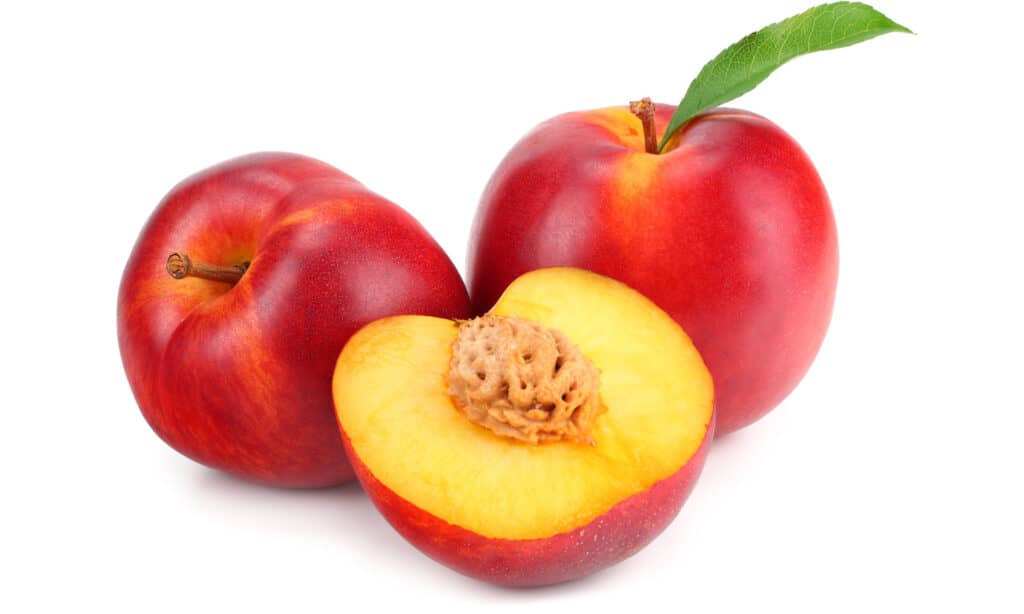
Technically, nectarines are peaches but they’re smaller and have smooth, non-fuzzy skin.
©iStock.com/Dmytro
The photo featured at the top of this post is © Piyaset/Shutterstock.com
Thank you for reading! Have some feedback for us? Contact the AZ Animals editorial team.






